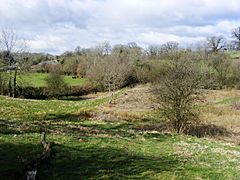Windsor Hill Marsh facts for kids
| Site of Special Scientific Interest | |
 |
|
| Area of Search | Somerset |
|---|---|
| Coordinates | 51°12′24″N 2°32′48″W / 51.20653°N 2.54676°W |
| Interest | Biological |
| Area | 0.84 hectares (0.0084 km2; 0.0032 sq mi) |
| Notification | 1972 |
Windsor Hill Marsh is a special place in Somerset, England. It's a small area, about the size of one football field, that is protected because of its amazing plants and natural features. It's located north of the town of Shepton Mallet.
This marsh is right next to Windsor Hill Quarry, which is also a protected site, but for its rocks and geology. Windsor Hill Marsh was officially recognized as a special site in January 1972.
Windsor Hill Marsh is mainly a wet, muddy pond that has slowly filled with dirt over time. Around it, you'll find damp, slightly acidic grassland. There's also a limestone bank and a small stream that flows into a swallet. A swallet is like a natural drain where water disappears underground into caves or cracks in the rock.
Contents
What is a Site of Special Scientific Interest (SSSI)?
A Site of Special Scientific Interest (SSSI) is a special area in the United Kingdom. These places are protected by law because they have important wildlife, plants, or geological features. The government wants to make sure these unique spots are kept safe for nature and for people to study.
Windsor Hill Marsh is a "biological SSSI." This means it's protected because of its living things, especially its plants. Other SSSIs might be "geological SSSIs," protected for their rocks, fossils, or landforms.
Why is Windsor Hill Marsh Special?
This small marsh is home to a surprising number of different plants. Experts have found 114 different types of plants here! This is because the area has many different kinds of habitats, even though it's not very big. You can find wet marshland, damp grass, and even a limestone bank, all in one spot.
Rare Plants at Windsor Hill Marsh
Two plant species found here are very rare in Somerset:
- Flatsedge (Blysmus compressus)
- Slender spike-rush (Eleocharis uniglumis)
Flatsedge was first found at Windsor Hill Marsh in 1946 by a person named Humphry Bowen. This plant doesn't grow anywhere else in Somerset, making its presence here very important.
Slender spike-rush was discovered in 1972 by Florence Gravestock. It's only found in one other place in Somerset, which is West Sedgemoor. Both of these rare plants were still growing well at Windsor Hill Marsh in 2004.
Other Plants You Can Find Here
Besides the rare plants, many other interesting marshland plants thrive at Windsor Hill Marsh. These include:
- Purple loosestrife
- Yellow flag (Iris pseudacorus)
- Hard rush (Juncus inflexus)
- Soft rush (Juncus effusus)
- Flowering rush (Butomus umbellatus)
- Devil's-bit scabious (Succisa pratensis)
- Three different kinds of horsetail plants (Equisetum species)
- Seven different kinds of sedge plants (Carex species)
These plants all help make Windsor Hill Marsh a rich and important habitat for local wildlife.
Images for kids


